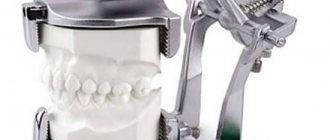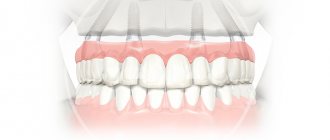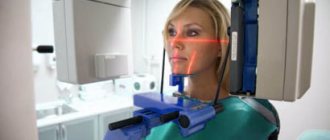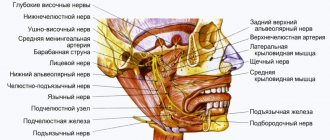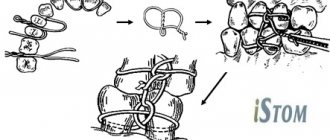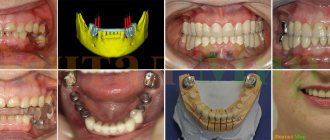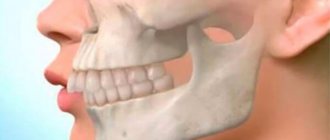The biomechanics of the lower jaw is considered from the point of view of the functional purpose of the dental system (speech, chewing, swallowing). Movements of the lower jaw are realized as a result of the interaction of the temporomandibular joint (TMJ), teeth and masticatory muscles.
This interaction is coordinated and controlled by the central nervous system. Voluntary and reflex movements are regulated by the neuromuscular system; they are carried out sequentially.
For example, the initial movements—biting food and placing it in the oral cavity—are voluntary. Chewing and swallowing are then carried out unconsciously.
Everything is not as simple as it seems
Directions of movements of the lower jaw
Forward, down, up, sideways
Movements of the lower jaw are possible in three directions, their list includes:
- vertical;
- sagittal;
- transverse.
Any movements in the lower jaw are realized under the condition of simultaneous sliding and rotation of its heads.
The distal fixed position of the lower jaw relative to the upper jaw is ensured by the TMJ. This joint also creates guide planes for forward, downward, and sideways movement. If there is no contact between the teeth, the direction of movement of the lower jaw is carried out thanks to the articulating articular surfaces and proprioceptive neuromuscular mechanisms.
The stability of the vertical and distal interaction between the lower and upper jaws is ensured by the intercuspal contact of the antagonist teeth. In addition, thanks to the tubercles of the teeth, guiding planes are formed for the movement of the lower jaw forward and to the sides.
During the movement of the lower jaw, when the teeth are in contact, the direction of movement is determined by the chewing surfaces of the teeth, and the joints perform a passive function.
Vertical movements
Movements when opening the mouth
Vertical movements that characterize the process of opening the oral cavity can be carried out under the condition of active bilateral contraction of the muscles that go from the lower jaw to the hyoid bone. In addition, the heaviness of the jaw itself also plays a role.
Mouth opening has three phases:
- insignificant;
- significant;
- maximum.
The amplitude of the vertical movement of the jaw is 4-5 cm. In the process of closing the oral cavity, the lifting of the jaw is achieved due to the simultaneous contraction of muscle structures.
In the TMJ, the heads of the lower jaw rotate together with the disc around its axis, then down and forward along the slope of the tubercles to the apexes during the opening of the oral cavity and in the opposite direction during the closing process.
Sagittal movements
They provide forward movement of the lower jaw. In this case, a complex of movements is carried out in the sagittal plane within the boundaries of movement of the interincisal point.
The jaw moves forward due to bilateral contraction of the lateral and medial pterygoid muscles, and partially the temporal muscles.
The movement of the head is divided into two phases:
- Sliding of the disc together with the head along the surface of the joint tubercle.
- Attachment of the articulated movement of the head around its transverse axis.
The sagittal articular path is the distance that the head of the jaw travels during forward movement. Its average size is from 7 to 10 mm.
Sagittal path angle
The angle of the sagittal articular path is the angle formed when the occlusal plane intersects the line of the sagittal path. It depends on the severity of the joint tubercle and the tubercles of the lateral teeth. The average angle is 33°.
The Spee curve (sagittal occlusal) runs from the upper third of the distal slope of the mandibular canine to the distal buccal tubercle of the extreme lower molar.
In the process of protrusion of the lower jaw, due to the presence of the Spee curve, interdental contacts arise, which ensure the harmony of occlusal relationships between the rows of teeth. Thanks to the sagittal curve, the unevenness of the occlusal surfaces is compensated, because of this it is also called compensatory.
The mechanism of forward movement of the jaw can be described as follows: during the movement, the head of the condylar process tends forward and down along the slope of the tubercle of the joint, the teeth of the lower jaw also tend forward and down. But when encountering the complexity of the relief of the occlusal surface of the teeth of the upper jaw, the teeth of the lower side form continuous contact with them until the dentition is separated due to the height of the central incisors.
During the process of sagittal movement, the central incisors located below will slide along the palatal surface of the incisors located above, that is, they pass the sagittal incisal path. The angle between the occlusal plane and the vector of the incisal path can vary, but its average value is from 40 to 50°.
That is, ensuring the preservation of tooth contacts in the process of jaw extension occurs due to the harmonious interaction between the articular and incisive paths and the tubercles of the chewing teeth.
Very important! If, in the manufacture of prostheses, both removable and fixed, the curvature of the compensatory curve is not taken into account, then overload of the articular discs is provoked. This inevitably leads to TMJ pathology.
Transversal movements
Transversal, or lateral movements are produced due to the predominantly unilateral contraction of the lateral pterygoid muscle. During movement of the jaw to the right side, contraction of the left lateral pterygoid muscle is observed, and vice versa. The jaw head on the displacement side rotates around a vertical axis.
On the balancing side (the side of muscle contraction), the head of the lower jaw slides along the articular surface of the tubercle along the articular surface of the tubercle forward, down and slightly inward, that is, it makes a lateral articular path. The angle of the transversal articular path (Bennett's angle) is formed between the lines of the lateral and sagittal articular path. Its average value is approximately 17o.
Bennett Corner (17) and Gothic Corner (110)
Lateral movements are characterized by some changes in the position of the teeth. The intersection of the curved transversal displacements of the anterior teeth at the interincisal point occurs at an obtuse angle. This is the angle of the transversal incisal path, which is otherwise called Gothic. Its average value is from 100 to 110o. It characterizes the span of the incisors.
Lateral movement to the left
On the working side, the lateral teeth are located with the same tubercles relative to each other, and on the balancing side they are in an open state. The transversal occlusal curve (Wilson) connects the buccal and lingual cusps of the chewing teeth on one side with the same ones on the other side. The radius of curvature of the Wilson curve is 95 mm.
It is important to consider the types of opening of the dentition:
- Canine guidance . When performing lateral movements of the lower jaw, the condylar process on the balancing side moves forward, down and inward. At the same time, the plane of inclination of the jaw changes. The opening of the dentition is observed only when the fangs come into contact.
- Canine-premolar guidance . At the moment of opening the molars of the working side, the canines and premolars come into contact.
Note! In the process of making fixed dentures, it is important to find out the type of release characteristic of a particular patient.
The type of opening is determined based on the height of the fangs and the opposite side. If this is not possible, a prosthesis with a canine-premolar type of guidance should be made.
This prevents overloading of the articular discs and periodontal tissues. Compliance with the radius of curvature of the Wilson curve helps prevent supercontacts of the chewing teeth when making lateral movements of the lower jaw.
Midpoint displacement trajectories
The central relationship of the jaws is the starting point of all movements carried out by the lower jaw. It is distinguished by the uppermost localization of the heads of the joints and the tubercular contact of the lateral teeth.
Afterwards, the jaw moves to a more stable position, in which maximum fissure-tubercle contact is possible. The sliding of teeth within 1 mm from the localization of the centric relation to the central occlusion is directed forward and upward in the sagittal plane. This is referred to as “center sliding.”
Important! The considered data is used in the process of programming the articular mechanisms of devices that simulate the movements of the lower jaw.
Vertical and sagittal movements of the lower jaw. Articular and incisal gliding path.
Vertical movements of the lower jaw correspond to the opening and closing of the mouth. It is typical for opening the mouth and introducing food into the mouth that at this moment the selected optimal action option is triggered, depending on the visual analysis of the nature of the food and the size of the food bolus. So, a sandwich, seeds are placed in the incisor group, fruits, meat - closer to the canine, nuts - to the premolars. Thus, when the mouth opens, a spatial displacement of the entire lower jaw occurs (Fig. 33).
Depending on the amplitude of mouth opening, one or another movement predominates. With slight opening of the mouth (whispering, quiet speech, drinking), rotation of the head around the transverse axis in the lower part of the joint predominates; with a more significant opening of the mouth (loud speech, biting food), the rotational movement is joined by the sliding of the head and disc along the slope of the articular tubercle down and forward. With maximum mouth opening, the articular discs and mandibular heads are installed on the tops of the articular tubercles. Further movement of the articular heads is delayed by the tension of the muscular and ligamentous apparatus, and again only rotational or hinge movement remains. The movement of the articular heads when opening the mouth can be observed by placing the fingers in front of the tragus of the ear or inserting them into the external auditory canal. The amplitude of mouth opening is strictly individual. On average, it is 4-5 cm. The dentition of the lower jaw describes a curve when opening the mouth, the center of which lies in the middle of the articular head (Fig. 34). Each tooth also describes a certain curve (Fig. 35).
Sagittal movements of the lower jaw. The forward movement of the mandible is carried out mainly due to bilateral contraction of the lateral pterygoid muscles and can be divided into two phases: in the first, the disc together with the head of the mandible slides along the articular surface of the tubercle, and then in the second phase a hinge movement is added around the transverse axis passing through the heads. This movement occurs simultaneously in both joints. The distance that the articular head travels is called the sagittal articular path. This path is characterized by a certain angle, which is formed by the intersection of a line that is a continuation of the sagittal articular path with the occlusal (prosthetic) plane. The latter is understood as a plane passing through the cutting edges of the first incisors of the lower jaw and the distal buccal cusps of the last molars (Fig. 36). The angle of the sagittal articular path is individual and ranges from 20 to 40°, but its average value, according to Gysi, is 33°.
This combined pattern of movement of the lower jaw is found only in humans. The magnitude of the angle depends on the inclination, the degree of development of the articular tubercle and the amount of overlap by the upper anterior teeth of the lower anterior teeth. With deep overlap, rotation of the head will predominate; with small overlap, sliding will prevail. With a direct bite, the movements will be mainly sliding. Moving the lower jaw forward with an orthognathic bite is possible if the incisors of the lower jaw come out of the overlap, that is, the lowering of the lower jaw must first occur. This movement is accompanied by sliding of the lower incisors along the palatal surface of the upper ones until direct closure, that is, until anterior occlusion. The path taken by the lower incisors is called the sagittal incisal path. When it intersects with the occlusal (prosthetic) plane, an angle is formed, which is called the angle of the sagittal incisal path (Fig. 37 and 33).
It is also strictly individual, but, according to Gysi, it is in the range of 40-50°. Since during movement the mandibular articular head slides down and forward, the back part of the lower jaw naturally moves down and forward by the amount of incisal sliding. Consequently, when lowering the lower jaw, a distance between the chewing teeth should be formed equal to the amount of incisal overlap.
11. Transversal movements of the lower jaw. The concept of working and balancing sides. Phases of chewing movements of the lower jaw.
Transverse (lateral) movements of the mandible occur as a result of unilateral contraction of the lateral pterygoid muscle. When moving to the right, the left lateral pterygoid muscle contracts, and when moving to the left, the right muscle contracts.
During the transversal movement of the lower jaw, two sides are distinguished: working and balancing.
Laterotrusion (working movement) is the movement of the lower jaw from the position of central occlusion or central ratio in the direction of the working side, in which it deviates outward from the midsagittal plane.
Working side ( laterotrusive side) – the side towards which the movement of the lower jaw is directed from the position of central occlusion or centric relation.
Mediotrusion (non-working movement) is a movement of the lower jaw in which it deviates towards the midsagittal plane.
Non-working side (balancing, mediotrusive) - the side opposite (contralateral) to the working side when performing a working movement.
On the working side, where the movement of the jaw is directed, the chewing antagonist teeth are installed with identical tubercles, and on the opposite (balancing) side - with opposite ones. On the working side, the head remains in the hole and rotates only around its vertical axis. On the balancing side, the head together with the disc slides along the surface of the articular tubercle down and forward, as well as inward, forming an angle with the original direction of the line of the sagittal articular path. This angle was first described by Bennett and is called the angle of the transversal articular path (LATERAL ARTICULAR ANGLE ( Bennett's angle ), which is 15-20° (Fig. 37). It is depicted as a projection of two straight lines onto the Frankfort horizontal line.
Rice. 38. Angle of the transversal articular path (Bennett's movement).
Transversal movements are characterized by certain changes in the position of the teeth. If you graphically depict the curves of tooth movement during alternate movement of the lower jaw to the right and left, then they intersect at an obtuse angle. The farther the tooth is from the head, the greater the angle. The most obtuse angle is formed from the intersection of curves formed by the movement of the central incisors. This angle is called GOTHIC or TRANSVERSAL (LATERAL) INCISIVE PATH ANGLE and is on average 100 - 110°. It determines the span of the incisors during lateral movements of the lower jaw (Fig. 39).
The gothic angle recording is used to determine the centric relation of the jaws and centric occlusion.
Fig.39. Transversal incisal path.
The full range of movements of the mandible can be illustrated by a diagram showing the spatial movement of the midpoint between the central lower incisors. A three-dimensional image of the trajectory of movement of this point, obtained by U. Posselt by superimposing lateral radiographs of the skull, clearly demonstrates the complexity of the movements of the lower jaw (Fig. 40).
Rice. 40. Three-dimensional image of a complex of functional movements
lower jaw according to U. Posselt.
When chewing, the lower jaw undergoes a cycle of movements accompanied by the appearance of rapid sliding contacts of the teeth on the working side. Maximum chewing forces develop in the position of central occlusion. There are four phases of chewing. In the first phase, the jaw lowers and moves forward. In the second, the jaw shifts to the side (lateral movement). In the third phase, the teeth close on the working side with like-named tubercles, and on the balancing side with opposite ones. However, there may be no contact between the teeth on the balancing side, which depends on the severity of the transversal occlusal curves. In the fourth phase, the teeth return to the position of central occlusion (Fig. 41).
Rice. 41. Cycle of chewing movements according to U. Posselt.
The shape of the chewing cycle can be different depending on the degree of overlap and inclination of the front teeth, the height of the cusps of the chewing teeth, etc. In this regard, horizontal and vertical forms of the chewing cycle are distinguished (Fig. 42). The volume of movements of the lower jaw necessary to carry out the chewing cycle is, as a rule, less than the volume of all possible movements.
a b
a - horizontal form of the chewing cycle; b - vertical form of the chewing cycle.
Rice. 42. Forms of the chewing cycle according to U. Posselt.
Gothic arc . When viewed from above, the movements of the lower jaw in the horizontal plane during its extending right and left lateral movements to the limit, the trajectory of the midpoint of the lower incisors resembles an arrowhead or an arch. The top of this arc corresponds to the position of the central relation. The sides of the arc correspond to the trajectory of rotation of the midpoint of the lower incisors around the vertical axes of the working articular heads during the right and left lateral movements of the lower jaw to the limit.
The relationship between the sagittal incisal and articular tracts and the nature of occlusion has been studied by many authors. Bonneville, based on his research, derived the laws that are the basis for the construction of anatomical aritculators.
Bonneville's triangle is the relationship between the incisal point and the right and left heads of the temporomandibular joint. This is an equilateral triangle with a side length of about 10.5 cm. It is the basis for articulators tuned to average anatomical parameters. Considering the movements of the lower jaw carried out by the muscles of the maxillofacial region, three groups of muscle movements can be distinguished:
- conscious movements - moving the lower jaw forward, consciously opening the mouth;
- reflex movements - mandibular reflex, mouth opening reflex;
- rhythmic movements - chewing, articulation.
Chewing movements are complex, they include movements of the jaws, chewing and facial muscles and tongue, and soft tissues of the face. The lips, cheeks and tongue control the position of the bolus of food in the oral cavity and its retention on the occlusal surface. The following phases of the chewing cycle are distinguished:
1. preparatory phase - formation and preparation of the food bolus for crushing.
2. grinding phase - crushing and grinding the food bolus, mixing it with saliva on the working side (laterotrusive).
3. final formation of the food bolus before swallowing - mixing of the food bolus with saliva.
In all phases of the chewing cycle, the following movements are distinguished: group and working guiding functions, canine guidance.
Working guiding function (teeth-directed lateral movement of the lower jaw from the position of central occlusion) - the lateral movement of the lower jaw from the position of central occlusion with the teeth closed is directed by the contacting surfaces of these teeth on the working side. In natural dentition, two types of working guiding function are most often found: “canine path” and “group guiding function”.
Group guiding function (unilateral protection) - contact of the buccal cusps of molars and premolars in lateral occlusion on the working sides. Occurs in 16.3% of cases.
The canine path is the sliding of the apex or distobuccal slope of the lower canine of the working side along the palatal slope of the upper canine of the working side when the muscles move the lower jaw to the working side. This causes the lower jaw to move sideways, forward, and open the mouth. During the canine-guided working movement, the central and lateral incisors of the working side can simultaneously be in movable contact with the opposing central and lateral incisors. In a canine-guided working movement, the premolars and molars on the working side are opened while the mandible moves away from the centric occlusion position. All teeth on the non-working side open during this movement. The canine tract provides the anterior guide component, and the articular tract constitutes the distal guide component and provides the opening of the teeth on the non-working side. The canine route occurs in 57%.
Canine protection - contact of the canines in lateral occlusion on the working sides.
Anterior guiding function (incisal path) - When the incisors and canines guide both the forward and working movements of the mandible, they constitute the anterior guiding component of its movements.
Group working guiding function - the working guiding function of a group of teeth is carried out by all teeth of the working side. The cutting edges of the anterior teeth of the lower jaw slide along the palatal surfaces of the anterior teeth of the upper jaw. The buccal slopes of the buccal cusps of the lower premolars and immolars slide along the palatal slopes of the buccal cusps of the upper premolars and molars.
Chewing phases:
1) the phase of grasping and cutting food, which is characterized by sliding of the cutting edges of the lower frontal teeth along the palatal surface of the upper ones until their marginal closure and back; in this phase, the forward movement of the lower jaw predominates and, therefore, the teeth are set in anterior occlusion;
2) the phase of crushing food, which is carried out by the vertical movement of the lower jaw and is characterized by maximum contact of the teeth of both jaws; occlusion of the dentition in this phase is called central and is the initial and final moment of all chewing movements of the lower jaw;
3) the phase of grinding food, which is characterized by alternating movements of the lower jaw to the sides, and when the lower jaw moves in any direction on this side, the cusps of the chewing teeth of the lower jaw will contact the cusps of the same name in the upper jaw (buccal with buccal, palatal with lingual).
Functional significance of the tubercles
The buccal cusps of the upper and lower molars, as well as the lingual cusp of the lower molar, perform a protective function. The palatal cusp of the upper molar is the supporting one.
In the process of closing the teeth in the central position, contact occurs between the palatal tubercles of the upper teeth and the central fossae or marginal projections of the molars and premolars of the lower jaw. There is also contact between the buccal tubercles of the lower teeth and the central fossae and marginal projections of the molars and premolars located above.
Note! The buccal tubercles of the teeth of the lower jaw and the palatine tubercles of the upper are supporting and holding ones. The lingual cusps of the lower teeth and the buccal cusps of the upper teeth are guides and protective (prevent biting the cheek and tongue).
When performing chewing movements, the lower jaw should slide over the surface of the upper jaw teeth without obstacles. The tubercles slide smoothly along the antagonist slopes without disrupting occlusal relationships.
At the same time, they must maintain tight contact. Sagittal and lateral movements are reflected on the surface of the first molars of the mandible by the arrangement of transverse and longitudinal fissures, this is called the “occlusal compass”.
Important! This landmark is necessary in the process of modeling the occlusal surface of the teeth.
During the movement of the lower jaw forward, the guide tubercles of the chewing teeth of the upper localization slide along the central fissure of the teeth located below. During lateral movements, gliding occurs along the fissure that separates the median buccal and posterobuccal cusps of the lower molar.
In the process of combined movement, gliding occurs along the diagonal fissure that divides the median buccal tubercle. The “occlusal compass” is characteristic of all teeth of the lateral group.
“Occlusal compass” - A and C - sagittal movements, B and E - transversal, D - combined.
Another important factor in the biomechanics of the lower jaw is the height of the cusps of the chewing teeth. This parameter determines the amount of initial joint displacement.
This is due to the fact that during the lateral movements of the lower jaw, the head on the working side moves outward before the rotational movements begin, while the head on the balancing side moves inward. This type of movement occurs within 0-2 mm.
The greater the flatness of the slopes of the tubercles, the greater will be the magnitude of the initial articular shift. This is how the free mobility of the dentition relative to each other within the boundaries of central occlusion is determined.
Note! In the process of modeling artificial teeth, it is very important to take into account the characteristics of the tubercles, as well as the inclinations of the slopes of the chewing teeth. Otherwise, disturbances in the interaction of the elements of the TMJ are possible, that is, the progression of joint dysfunction.
